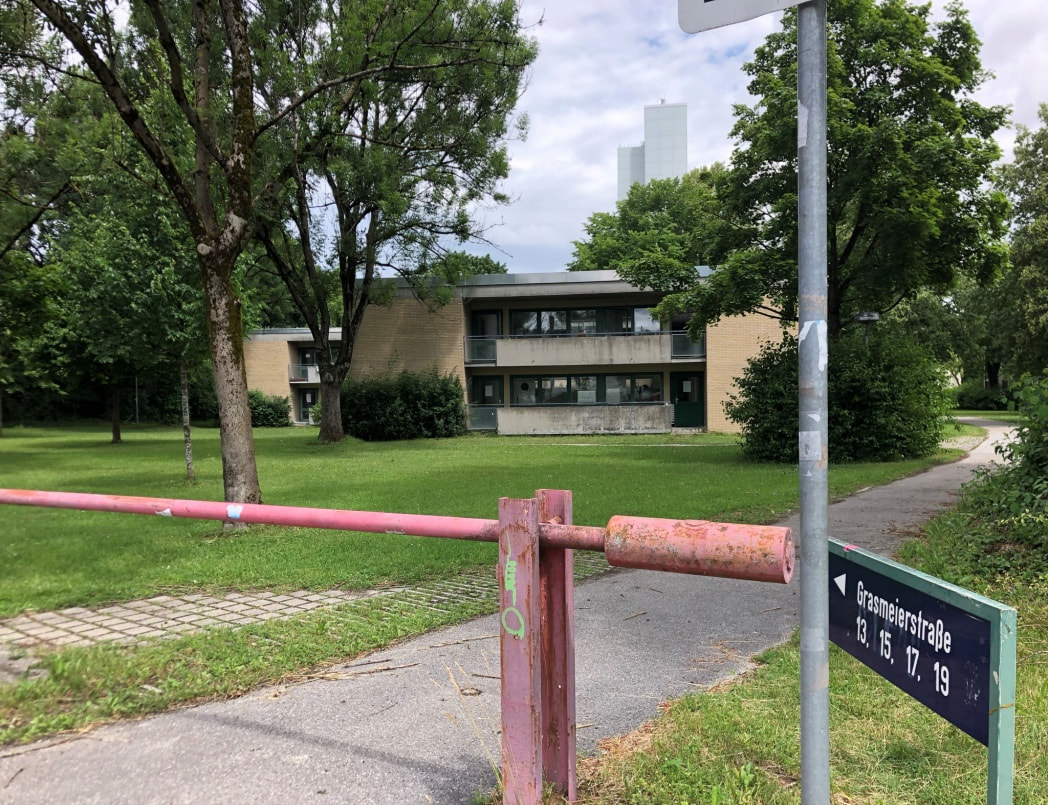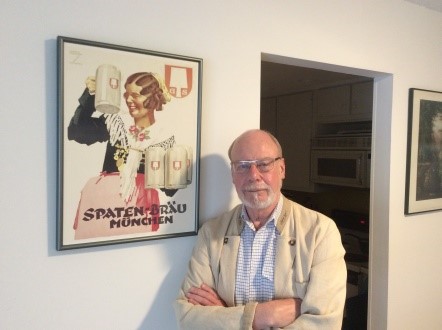Recollections of the Studentenstadt Freimann Stunde Null, 1963

Throughout the program's history, JYM students have lived in either homestays or various dormitories of the Studentenwerk München. The last few decades have been spent in the most well-known of all the 'Wohnanlagen' in Munich, namely the Studentenstadt Freimann, a.k.a. StuStadt or StuSta.
JYM knows the StuSta best for its Neustadt - first built in 1972 for the Olympics - the Grünes Haus being the tallest with the Manhattan, the Blaues Haus with the TriBühne, the Oranges Haus with the Pot-Schamperl, the Rotes Haus with the Bistro and Sauna. If you leave the Neustadt high-rises and walk towards the Englischer Garten you pass by several bungalow-style buildings, the "Atriumshäuser" and a few smaller high-rises like the Max Kade House belonging to the 'Altstadt' of Studentenstadt. One JYM alum recalls for us the historic opening of these first buildings in the Altstadt - he was one of its very first residents nearly 60 years ago!
Carl Hammer (JYM 1963-1964) shares his memories of StuSta in the old days. Though much has changed over the years, one thing has always remained the same and JYM alumni residents of any generation will be able to relate to what Carl Hammer says made Studentenstadt so special right from the start.
When I arrived in Munich for the new semester in autumn 1963, I was among the first to benefit from an innovation in German student life. Traditionally, German students lived in private lodgings, digs or "die Bude", but near the north end of the Englischer Garten (Hirschau), there was now a brand-new dormitory complex, the Studentenstadt Freimann, which was connected to the university by the Number 6 and 16 trams, now subways. I got a double room in one of the low atrium houses as did, if I remember correctly, my JYM friend also from Amherst, Larry Henderson. When I say that those buildings were brand new, I mean that literally.
On the first morning, as I woke up an electrician in blue overalls was leaning over me with an electric drill to install the reading light over the head of my bed. But the Studentenstadt was generally a very quiet place in a bucolic setting by the Englischer Garten. One morning I heard a strange noise. It was a flock of sheep being driven through the dormitory complex by their old shepherd to their pastures by the small stream that separated the Hirschpark (or Hirschau). The still entirely rural villages of Unterföhring and Ismanning were easy to reach by bike. There one could drink beer in peace with the experience immeasurably enhanced by the buzz of flies and the rich aromas from nearby dung heaps.

Unlike my experience of Amherst dormitories, there was no trace of "in loco parentis". The residents were expected to behave responsibly with consideration for their neighbors and did. In fact, they were a very different bunch than American undergraduates. The Studentenstadt was from the beginning open to all people, men, and women, studying at one of the higher-level academic institutions which in those days were the Uni (never referred to as the LMU), the Technische Hochschule, the Musikhochschule, and the Akademie der bildenden Künste.
So, the students were diverse in their academic interests, and there were a fair number of foreign students, many of whom were from the Mideast. Our house had, besides me, two Turks and a Greek Cypriot, an interesting mixture at that time. Most of them were studying engineering at the TH as was my first roommate, a Palestinian DP resident in Damascus, who listened every evening to Radio Cairo and regularly explained to me what a great man President Nasser was. My next roommate was a German medical student, Jewish by birth, who had been adopted and raised by a Protestant family and had done his secondary "Bacc" in France. There was plenty of variety. A civil engineering student from Iceland, Gylfi Ísaksson, was the best man at my 1967 wedding in Akureyri and is still a good friend.
Since dormitories were then an innovation, the residents were a self-selected group and, I believe, more mature than the average. Most were in advanced semesters, and many were studying for their final exams. Their academic interests were narrowly professional, but all of them had had a good general education from the gymnasium, and their cultural and intellectual interests were broad.
I particularly remember attending a recital in the Studentenstadt auditorium by a tenor from our house who also sang at the Michaelskirche; and also one evening in our kitchen-dining room hearing an informal explanation by an older mechanical engineering student of the principle of torque, "Drehmoment", using a spoon to illustrate. One of the other engineering students initiated a building project in an unused basement space which involved all of us wielding sledgehammers to knock out a wall. In the end, we had a nice bar with a tap which was also open to students from the other houses. All built by us.

I also learned some less admirable things. One evening, I was studying for the Middle High German exam of the university's Proseminar. A German who also was taking the course dropped by, and I asked him if he had memorized all of the philological complexities. He said he didn't need to because he had prepared a "Spickzettel" or crib sheet. The next morning the instructor handed out the exams and delivered a little speech to the effect that anyone who cheats only cheats himself. She then left the room, and everyone immediately pulled out their crib sheets. I had to struggle unaided. I think I was given a charity pass, and I make no claim here to personal virtue. Much later I again met my friend with the Spickzettel when he was a senior official in the manuscripts division at the Bayerische Staatsbibliothek.
I have spent some time at the Studentenstadt because it was the most important part of my education that year. The classes at the Uni and the JYM courses were, of course, also valuable, and they provided the necessary structure and legitimacy for my life in a German student community. But the Studentenstadt was, as my wife, a former TESOL teacher, would say, "immersive". It was in the dormitory that I learned whatever was fluent in my German by example from my fellows, including the Turks. But their example also shaped my attitude toward education and life.
I have no doubt that my modest success working in Germany for a former Daimler-Benz division was due to my experience at the Studentenstadt. I had no problem fitting in culturally at work which is much more difficult than learning the language. More generally and importantly, I learned how to appreciate another person's point of view without necessarily agreeing with it. The USA held a very different international status than now, but that did not imply that everyone was happy with us. No one was ever rude to me, but in some conversations, there was an unmistakable undertone of resentment and an occasional pointed remark.
My German housemates were not shy in that regard, which was notable because in those pre-Vietnam days, it was almost taboo for a German to say anything derogatory about America, particularly to an American. I took their frankness, which was more regretful than hostile, as a sign that I had been accepted into their community and their trust - very similar to my later colleagues at Daimler. And I experienced an outpouring of genuine affection for America when Kennedy was assassinated in November. A dance had been scheduled for that evening, and I was having a drink in my room with an old hometown friend, Judy Sutton, who that year was also on the JYM, from Vassar.
When we went over to the auditorium, the dance had already been closed, and many of my fellow students came up to express their sympathies almost as though I had experienced a personal loss. Some of them were clearly shaken. A Turk approached me with tears in his eyes, embraced me, and told me it was as though he had lost a father. I doubt any American will ever again have a similar experience. On 9/11, I was in Eichstätt, a university town north of Munich, and the reaction, though sympathetic, was quite different and much more distanced. But I am pleased to see that the JYM connection with the Studentenstadt continues and am quite sure that the participants today gain very much the same benefit that I did in that first year.

Following the JYM, Carl Hammer graduated from Amherst College and from the University of Toronto (Ph.D. in Medieval Studies). After a brief teaching career, he held executive positions in international business with Westinghouse and the former rail systems division of Daimler Benz.
In retirement, he has published seven monographs and numerous articles on medieval and early-modern history in N. American and European academic journals. One recent monograph dealt with the western Bavarian landscape in the early medieval period entitled Huosiland: A Small Country in Carolingian Europe. Carl Hammer currently lives in Pittsburgh and Easthampton, MA, and is a Research Associate at the University of Pittsburgh.
Studentenwerk celebrated its 100th anniversary in 2020. In honor of this milestone, they published an online 100 Jahre Flipbook featuring the historical milestones from its meager beginnings through many building phases up to current and upcoming projects.